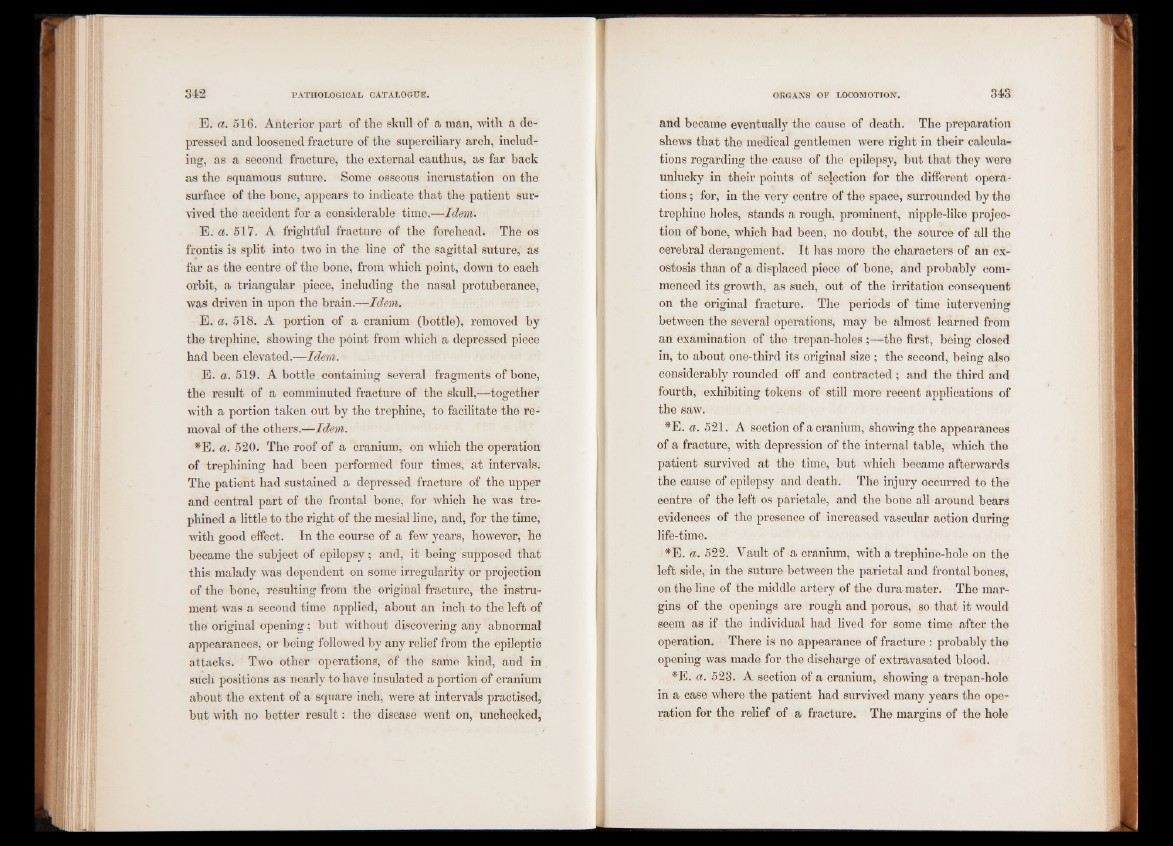
E. a. 516. Anterior part of the skull of a man, with a depressed
and loosened fracture of the superciliary aroh, including,
as a second fracture, the external canthus, as far back
as the squamous suture. Some osseous incrustation on the
surface of the bone, appears to indicate that the patient survived
the accident for a considerable time.—Idem.
E. a. 517. A frightful fracture of the forehead. The os
frontis is split into two in the line of the sagittal suture, as
far as the centre of the bone, from which point, down to each
orbit, a triangular piece, including the nasal protuberance,
was driven in upon the brain.—Idem.
E. a. 518. A portion of a cranium (bottle), removed by
the trephine, showing the point from which a depressed piece
had been elevated.—Idem.
E. a. 519. A bottle containing several fragments of bone,
the result of a comminuted fracture of the skull,—together
with a portion taken out by the trephine, to facilitate the removal
of the others.—Idem.
*E. a. 520. The roof of a cranium, on which the operation
of trephining had been performed four times, at intervals.
The patient had sustained a depressed fracture of the upper
and central part of the frontal bone, for which he was trephined
a little to the right of the mesial line, and, for the time,
with good effect. In the course of a few years, however, he
became the subject of epilepsy; and, it being supposed that
this malady was dependent on some irregularity or projection
of the bone, resulting from the original fracture, the instrument
was a second time applied, about an inch to the left of
the original opening; but without discovering any abnormal
appearances, or being followed by any relief from the epileptic
attacks. Two other operations, of the same kind, and in
such positions as nearly to have insulated a portion of cranium
about the extent of a square inch, were at intervals practised,
but with no better result: the disease went on, unchecked,
and became eventually the cause of death. The preparation
shews that the medical gentlemen were right in their calculations
regarding the cause of the epilepsy, but that they were
unlucky in their points of selection for the different operations
; for, in the very centre of the space, surrounded by the
trephine holes, stands a rough, prominent, nipple-like projection
of bone, which had been, no doubt, the source of all the
cerebral derangement. It has more the characters of an exostosis
than of a displaced piece of bone, and probably commenced
its growth, as such, out of the irritation consequent
on the original fracture. The periods of time intervening
between the several operations, may be almost learned from
an examination of the trepan-holes ;—the first, being closed
in, to about one-third its original size ; the second, being also
considerably rounded off and contracted; and the third and
fourth, exhibiting tokens of still more recent applications of
the saw.
*E. a. 521. A section of a cranium, showing the appearances
of a fracture, with depression of the internal table, which the
patient survived at the time, but which became afterwards
the cause of epilepsy and death. The injury occurred to the
centre of the left os parietale, and the bone all around bears
evidences of the presence of increased vascular action during
life-time.
*E. a. 522. Vault of a cranium, with a trephine-hole on the
left side, in the suture between the parietal and frontal bones,
on the line of the middle artery of the dura mater. The margins
of the openings are rough and porous, so that it would
seem as if the individual had lived for some time after the
operation. There is no appearance of fracture : probably the
opening was made for the discharge of extravasated blood.
*E. a. 523. A section of a cranium, showing a trepan-hole
in a case where the patient had survived many years the operation
for the relief of a fracture. The margins of the hole